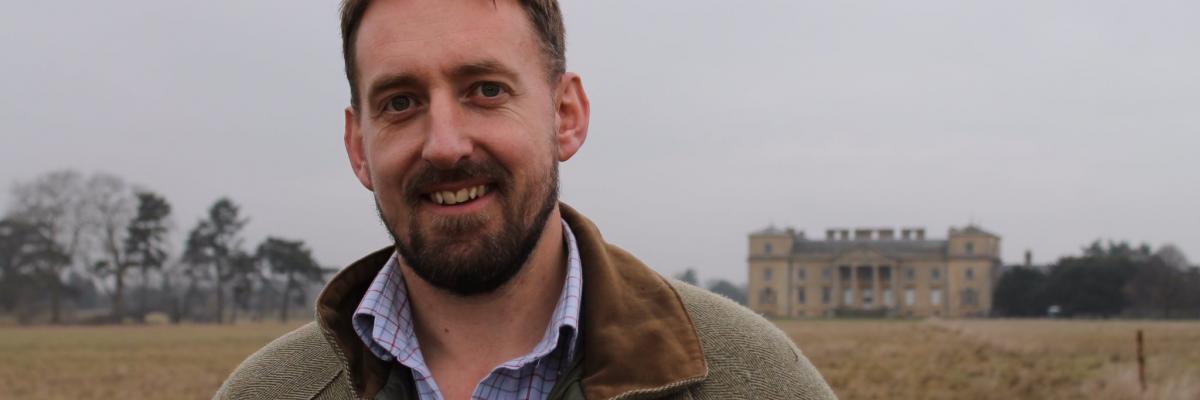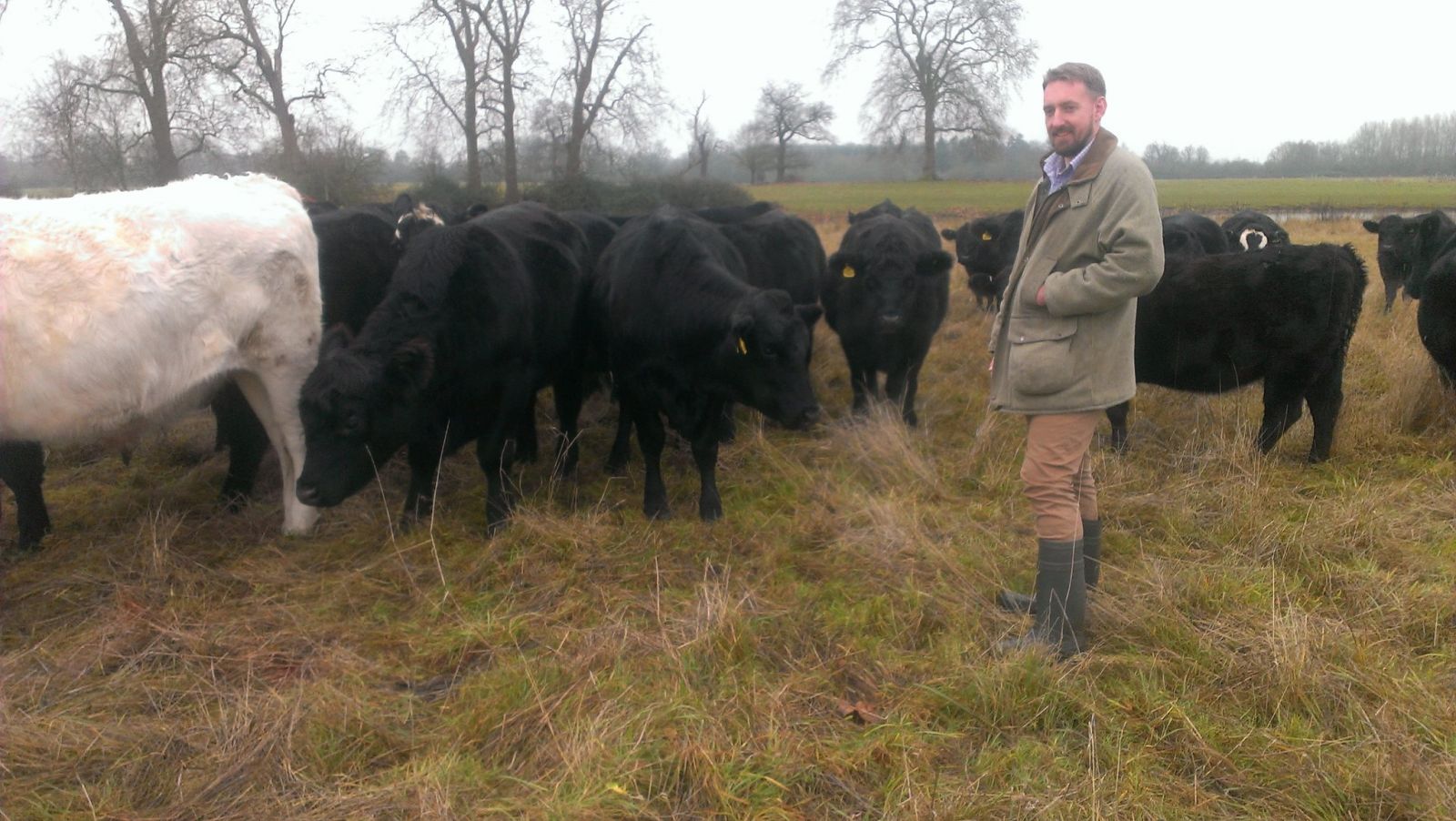
Rob Havard
Farmer
|
Agricology Field Day Find out more about the farm and Rob's approach; download the handout for the field day hosted by Rob below, where you can also access presentations from the day:
Watch footage from the day here. |
The home farm is 50 acres of traditional Worcestershire countryside where I live with my wife Claire and 3 children Tom, Erin and Sophie. My mother, father, and my sister and her family also live on the farmstead. The land is all pasture with some old traditional orchards. We have been farming here since 1919 when my great grandfather moved from south Wales. We have always farmed sheep and cattle, have been in Environmental Stewardship schemes for well over 10 years now, and have recently converted to organic and certified Pasture for Life beef and lamb. Our main operation is fattening grass-fed organic Aberdeen Angus beef cattle.

We have a farm tenancy with the National Trust on 180 acres at Croome Court and have recently taken on a further 190 acres with a local landowner who is committed to ecological agriculture where we will set up a pedigree Angus suckler herd.
We use Holistic Planned Grazing to manage our livestock for the benefit of the cattle, the environment and the people involved. The beef is sold through the usual organic supply chain and we also sell our Aberdeen Angus through a supermarket scheme for Aberdeen Angus beef. We do some small scale direct sales which we hope to expand as we grow the cattle operation.
There are three 4 and 5 star self-catering cottages on the farm and a 2 acre course fishing lake. A common theme across all the land we farm is the creation and restoration of native species-rich grassland and making the most of these natural biodiverse pastures and proving that they can be productive and valuable for fattening stock.
Holistic Management/Holistic Planned Grazing (HPG)
We have been operating our grazing using HPG for about 3 years now and had rotationally grazed before that. We have found Holistic Management to be a great tool for setting the direction of the farm and making sure that our decisions are not running counter to our lifestyle goals or those of our immediate family. Setting goals that ensure that our decisions are tested against social, financial and environmental criteria, ensures that the future of the farm is not only sustainable but that the profitability, fertility and wildlife resources improve every year.
We use Holistic Planned Grazing to make the most of diverse native pastures and have restored many acres of native species-rich pastures. The livestock thrive on the pasture diversity that provides all their needs and allows us to fatten all stock from grass and natural herbs alone.
.jpg)
If you let your clover go to seed your cattle will reseed for you free of charge
We move cattle every 2 days (but it might be twice a day in really wet weather) and always have a back fence. The aim is to avoid re-grazing the growing plant and to maximise regrowth/rest periods. Our rotation is about 90 days in the summer while we try to build a stockpile of grass for winter grazing. We find that leaving at least 4 inches post grazing helps to maximise winter stockpile while also being the most nutritious parts of the plants for finishing store cattle on grass alone.
Stocking rate will determine how far we get through the winter on the stockpile - last year we wintered out on one farm on stockpile alone with no hay on very heavy clay. On another farm with a higher stocking rate we housed in mid-January. The aim of stockpiling is to reduce wintering costs, which is the main cost in the business and makes us much more resilient to price instability. In extreme weather years it might not be as effective but if we can save costs 3 years out of 4 then we are moving forward.
Using grazing techniques that are based on recreating natural processes allows us to grow fitter cattle for less money while leaving the land in a better state than when we found it. Populations of wild birds have been increasing year on year, the wildflowers are going from strength to strength, and we’re introducing more every year from local wildlife reserves.
It was a nervous first year when we aimed for wintering outside the whole year on heavy clay and no hay, and while we got to February 15th in the first winter, we managed to get through the whole winter on stockpiled forage for the first time this last year, which has had a massive financial benefit as well as improving the winter wildlife on the farm.
.jpg)
3 weeks Feb regrowth after hard grazing
%20still%20holding%20up%20well%20in%20mid%20Feb(2).jpg)
Cocksfoot (Orchard grass) still holding up well in mid Feb
“Ultimately, the only wealth that can sustain any community, economy or nation is derived from the photosynthetic process - green plants growing on regenerating soil." Allan Savory
Our family have been farming at Phepson since 1919. I am the fourth generation on the farm and we hope the next generation will want to carry on our work. At the turn of the century we were hit hard by both the BSE and then Foot and Mouth outbreaks. Despite not having either disease on the farm, we were hit by sudden market drops at critical times and then family illness at this time led to the sale of all but 50 acres.
I have been working as a professional ecologist for over 10 years and since joining the farm partnership in 2003, we have taken the farm in a more environmentally focused direction. We started grazing nature reserves for local wildlife charities to expand the farm, but more recently have taken on larger blocks of land and now farm over 420 acres.
Using Holistic Management allows us to ensure that the land, environment, people and our bottom line all benefit from our farming, and that is what gets us up in the morning.
In the future we will expand our direct sales so that we can connect with the end customer and complete the field-to-plate circle while giving more options for the next generation to come into the business. We aim to farm in Nature’s image; to keep the environment the way it was meant to be kept.
|
FARMER TIPS
|
To gain further insights into Holistic Management and find out more about Rob, view a guest blog article by Matt Clegg here.
All photo credits: Rob Havard
Disclaimer
The information contained within this profile reflects the views and practices of the profiled farmer and does not necessarily reflect that of Agricology and its partners.
Published September 2017

